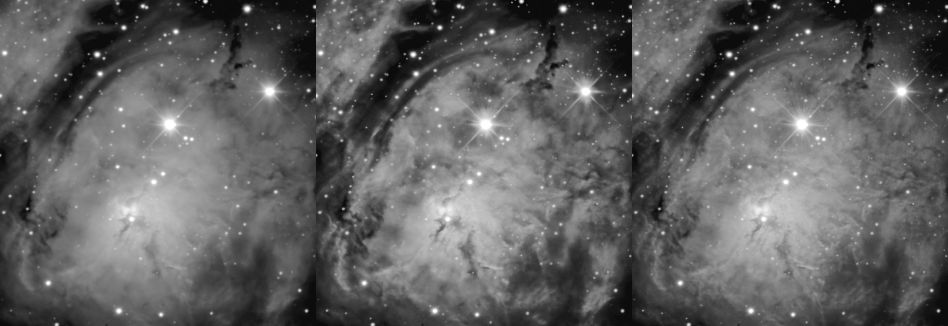Sharp: Multi-scale Noise-Aware Structural Detail Enhancement
Through wavelet decomposition function specifically designed for astrophotographical optical systems, StarTools' Detail-aware Wavelet Sharpening allows you to bring out faint structural detail in your images.
An important innovation over other, less sophisticated implementations, is that StarTools' Wavelet Sharpening gives you precise control over how detail across different scales and SNR areas interact. This means that;
- Sharp lets you control how detail is enhanced, based on the Signal-to-Noise Ratio (SNR) per-pixel in your image. This ability lets you dig out larger scale faint detail entirely without increasing perceived noise.
- Sharp lets you to be the arbiter when two scales (bands) are competing to enhance detail in their band for the same pixel.
- As opposed to other, less desirable implementations (such as median-based wavelet transforms found in some other software), the Sharp module retains all the benefits of a Gaussian transform (e.g. closely resembling the ideal signal responses for detail and PSFs for astrophotographical optical systems) while still avoiding the ringing artifacts. The Sharp module truly combines the best of both worlds.
Through wavelet decomposition function specifically designed for astrophotographical optical systems, StarTools' Detail-aware Wavelet Sharpening allows you to bring out faint structural detail in your images.
As with all modules in StarTools, the Wavelet Sharpening module will never allow you to clip your data, always yielding useful results, no matter how outrageous the values you choose, while availing of the Tracking feature's data mining. The latter makes sure that, contrary to other implementations, only detail that has sufficient signal is emphasised, while noise grain propagation is kept to a minimum.

Usage

Using the Sharp module, starts with specifying an upper limit of the size of the detail that should be accentuated via the 'Structure Size' parameter. You should only need to change this parameter if you wish very fine control over small details.
After pressing 'Next', a star mask should be created that protects bright stars (and their extending profiles) from being accentuated.
An 'Amount' parameter governs the strength of the overall sharpening.
The 'Scale n' parameters allow you to control which detail sizes are getting enhanced. If you wish to keep small details from being enhanced set 'Scale 1' to 0%, similarly if you wish to keep the very largest structures from being enhanced, set 'Scale 5' to 0%.
The 'Dark/Light Enhance' parameter gives you control over whether only bright or dark (or both) detail should be introduced.
The two 'Size Bias' parameters controls the detail size that should prevail if two scales are 'fighting' over enhancing the same pixel. A higher value gives more priority to finer detail, whereas a lower value gives more priority to larger scale structures. It is this ability of the Sharp modules, to dynamically switch between large and small detail enhancement that makes every combination of settings look coherent without 'overcooking' the image; the adage is that if you try to make everything (every scale) stand out, nothing stands out. And this is precisely what the Sharp module was designed for to avoid. Inherent to this approach is also the lack of ringing artefacts around sharp edges, even though the module does not employ a (less-ideal) multi-scale median transform to try to circumvent this. This combines the benefits of the response of a pure Gaussian transform (such as precise band delineation in an astrophotographical optical train, as well as noise modelling) with ringing artefact-free detail enhancement.
Two version of the 'Size Bias' parameter exist; the 'High SNR Size Bias' parameter and the 'Low SNR Size Bias' parameter. The distinction lies in a further refinement of where and how detail enhancement should be applied. The 'High SNR Size Bias' parameter controls the size priority for areas with a high signal-to-noise ratio (good signal), whereas the 'Low SNR Size Bias' controls the size priority for areas with a low signal-to-noise ratio (poor signal).
When Tracking is on, the Tracking feature tends help the Sharp module do a very precise job in making sure that noise is not exacerbated - you may find that the distinction is not needed for most datasets with signal of reasonable quality. However when Tracking is off, these parameters use local luminosity as a proxy for signal quality and the distinction between Low and High SNR will be much more important.
Finally, the 'Mask Fuzz' parameter increasingly smoothens the area over which the set mask goes from fully in effect, to not in effect.
Masked vs unmasked areas
Masks in the Sharp module are primarily used to indicate to the module where stars - and their halos - are located. However, even when masked out, these areas still get processed, though in a subtly different way; only dark detail is emphasised, but not light detail. This avoids accentuating of halos and star "bloating", yet still digs out detail that a stellar halo might be obscuring.
You may also be interested in...
- L. B., United States (under Testimonials)
I'm relatively new to image processing and just wanted to say how straight forward and powerful StarTools is.
- Heal: Unwanted Feature Removal (under Features & Documentation)
The Heal module incorporates an algorithm that is content aware and is able to synthesise extremely plausible substitution pixels for even the large areas.
- Color retention (under Usage)
The two aspects - colour and luminance - of your image are neatly separated thanks to StarTools' signal evolution Tracking engine.
- Usage (under Color)
Any decisions you make affecting your detail does not affect the colouring of said detail, and vice-versa.
- Zooming, panning and scaling (under Interface)
StarTools implements a custom scaling algorithm in its user interface, which makes sure that perceived noise levels stay constant, no matter the zoom level.
